Newarc Arctic expeditions
This page is currently undergoing major reconstruction in accordance with broader lore changes. |
The history of Newarc Arctic expeditions was a period of twenty-seven years, spanning from 1891 until 1918, during which the Arctic was explored by different Newarc explorers. This period was a massive boost in Newarc national pride as well as the introduction of Newarc naval presence in the Albion Sea, with much of these travels being sponsored by the Republican Navy as part of an effort to expand its ability to conduct blue-water operations in the Albion Sea.
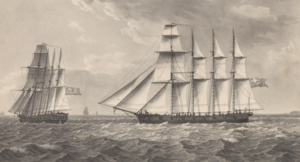
During this time period, the Arctic became the primary focus for New Archduchy as it held a great amount of scientific and geographical importance to the Newarc scientific community. As most of Crona was, and still is, predominantly populated by indigenous peoples, there were very few maritime-based opportunities for Newarcs to explore or venture beyond the southern half of the Albion Sea. Therefore, with the initial state-sponsored expedition of 1891, Newarc explorers, navigators, geographers, and officers ventured north through the Albion to stake their claim to the frozen expanses of the Arctic Circle. There were ten major expeditions, although smaller, privately-funded ones also occurred throughout this period but were not as intensely logged or chronicled.
The primary focus of many of the early expeditions were the use of new or novel technologies that expanded the limits of human endurance and physical stamina due to the exceedingly harsh conditions. As well, the Newarc climate, mostly plains and subtropical in nature, did not immediately outfit or set up the explorers for success, and the initial exposure/frostbite casualties of the 1891 and 1893 expeditions reflect this. Although official estimates vary between public and private sources, somewhere between two and three dozen Newarcs died during these initial forays into the Arctic.
The expeditions also claimed several important achievements for New Archduchy, notably being the first nation to have had a citizen successfully reach the North Pole, both geographic and magnetic. Previously, nomadic indigenous Cronan locals were assumed to have reached it, but this was the first time a modern nation state had achieved such an accomplishment. Additionally, much of the Arctic coastline was mapped during the first three expeditions, with John Howland's expedition accomplishing not only the survey task, but also the successful mission to the North Pole. The expeditions all generated a fair amount of scientific data for the greater Cronan scientific community, much of which became a focal point for inviting Newarc explorers and scientists to Levantia and Sarpedon for conferences and university tours to give lectures and share results with newer explorers.
Origins
Expeditions from 1891 until 1918
Expedition of 1891
This was the first expedition undertaken by New Archduchy to the Arctic, leaving in February 1891 from the Albion port of Adriansville, the capital city of New Archduchy, with the voyage not being entirely completed until late 1892. Led by Walter Hetherington, assisted by the soon-to-be-famous John Howland, it was primarily aimed at an initial survey and geographic mapping of the Arctic peninsulas to the east of Northern Crona, jutting out into the Albion Sea. During this expedition, Hetherington and Howland performed the first full oceanographic and coastal surveys of the northern shores of the Albion Sea. It also discovered two islands, those being Elizabeth Island and Gibson Island. Elizabeth Island was named for Hetherington's eldest daughter, and was discovered during the initial entrance into the northern reaches of the Albion Sea. Gibson Island was named after a member of the expedition who died after succumbing to cold-weather exposure injuries sustained while exploring the island. During the 1891 expedition, four separate landings and explorations were made by John Howland, the two aforementioned islands, as well as a pair of shore trips onto two separate peninsulas. The expeditions themselves were marked by harsh conditions due to the Arctic weather.
The government sponsored expeditionary research into much of the Cronan interior for safari-style forays into the continent, but serious maritime navigational exercises and missions have not been accomplished at this point by any Cronan nation. As such, the government contacted the Geography and Survey Department at the Arses Memorial University in Adriansville for a proposal on how they could feasibly explore the Arctic Circle. The head of the department at the time, Walter Hetherington, began recruiting from several sources. Scientific expertise was acquired from the university as well as several architecture and engineering firms in Adriansville and the Kuronian city of Valkas. For experience in colder climates and experts on mountaineering and long-distance patrolling, he requested volunteers from a pair of infantry regiments in the Republican Army that had particular expertise fighting rebel and guerilla forces. Of these was a former Captain of the Army, John Howland, By far the most important selection however was the maritime and naval experience, of which New Archduchy had little beyond some excursions in the southern reaches of the Albion Sea. Several merchantmen saw profitable opportunities, and career naval officers themselves saw this as a way to stake their claim and make their mark in the annals of the Republican Navy's history. As such, dozens of sailors and seamen from Adriansville volunteered for the task. With the personnel assembled and beginning preparations in Adriansville, the government had to procure a pair of sailing ships that could handle the expedition. The Navy had no suitable ships for cold-weather sailing, asides from a pair of ships that had already been commissioned for the Navy. The government made a requisition on the two vessels and had them retrofitted during construction to convert them to Arctic exploration vessels. The two three-masted Barquentines, named Chester and Emily, would each host a compliment of forty men and the needed supplies for travel to the Arctic circle. Training and supplies continued to be procured and conducted until February 1891, when the expedition set off.
With an initial stop in the Kiravian colony of Xepramonta, the expedition then set off for the Arctic. Arrival to the Arctic happened approximately a couple months after they had initially set out for the journey, with the two ships first sighting the Arctic Coast on 2 April 1891. With average temperatures at night around -10°C, and during the day around 5°C, the ships were frequently coated in ice. Considering the average temperature in New Archduchy at its coldest was roughly the same as some of these temperatures, many of the more experienced mountaineers and sailors had an easy time adapting thanks to their familiarity with the Albion Sea. The first foray ashore was made by John Howland on 6 April 1891 with him making initial surveys and taking some rock and soil samples. He was accompanied by three members of the Emily's crew, one of whom would later perish due to exposure and injuries sustained later in the expedition.
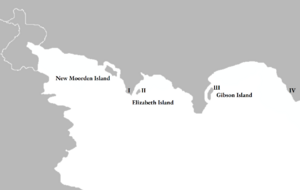
After the expedition on the Albion Peninsula, which lasted several days, the Chester and Emily both set off to what Hetherington would name Elizabeth Island. On Elizabeth Island, Howland found some signs of human life in the form of rock sculptures and carvings into the rocks on the north shore as well as limited cave exploration in the area, and came to the conclusion that these were from some of the indigenous peoples of Crona who have reached this area first. As preparations to leave Elizabeth Island went underway, the Emily struck an iceberg and required repairs, and the crews remained moored off the north shore for an additional four days while the sailors repaired the damaged hull enough to permit continuing travel.
Setting off at the end of May, the expedition made it around another peninsula and had sighted another island. It was also there that Nathan Gibson would become the first Newarc citizen to die in the Arctic. John Howland again led an expedition ashore onto the island, but on their second night a snowstorm destroyed much of their camp and supplies. Over a day's travel away from the moored ships, they struggled back across the rocky and snow-swept terrain back to the Chester, with many of the members suffering from frostbite and hypothermia. Nathan Gibson passed away within twenty-four hours, which greatly affected morale. Walter Hetherington decided to name the island in Gibson's honour, and they conducted a burial at a nearby shore; Gibson's gravesite still exists to this day, consisting of local rocks and a large cross hewn out of stone and secured with rope. The expedition continued, moving across the sea to the final part of the coastline where they sent a couple more shore parties for a longer stint, with Howland leading one of two parties. Both paties returned within a week to the coast to be recovered.

The expedition concluded, the ships began sailing south, successful in their voyage despite the loss of Gibson. They made the same port of call as part of the voyage back, and upon their return to New Archduchy, stopped for brief respite at the port of Adriansville before a parade was held in their honour. The scientific data and navigational charts made were methodically studied and used to plan the expedition of 1893, which was again to be led by Walter Hetherington. The impact was incredibly culturally significant. Walter Hetherington and John Howland became household names in New Archduchy, and the Rector of New Archduchy, Michael Ailio, sent a letter of congratulations to Hetherington and Howland congratulating the two on their expedition, even going so far as extending an invitation to Hetherington to personally receive an audience with Ailio at the official residence of the Rector.
Expedition of 1892
Capitalizing on the success of the 1891 expedition, the newly-established Common Council authorized the raising of a second expedition which was expected to take place the following year. Preparations, however, were considerably more rushed and this would result in delays and eventual catastrophe. The schooner Emily, still not fully repaired, was not chosen to again participate as one of the ships in the expedition. Chester was to be accompanied by a new schooner, Forthright, as well as one of the Navy's first frigates, Archer. The Navy was keen on testing their first frigate's ability to operate far beyond the southern reaches of the Albion. If this was successful Archer could be used as a precedent for additional ships to be constructed. The ships finished preparations not even a full year after return of the 1891 expedition, departing in the summer of 1892.
They followed a similar route, making resupply stops at ports of call in Xepramonta, but instead of focusing on the northern reaches of the Albion Sea, the expedition intended to head further east, closer to mainland Kiravia, as this stretch of coastline had very few surveys and geographical assessments done due to its remoteness. The main miscalculation here was the poor lack of accountability for the weather impact. Previously, the departure with the turn of spring in the northern hemisphere meant that the temperature was more permissive to the explorers upon their arrival in April 1891. For this expedition however, the summer departure as well as farther distance meant that the expected November arrival brought with it considerable storms and seas which the Forthright particularly struggled in.
After a storm in October south of Gibson Island whilst venturing eastwards, the Forthright lost a mast, resulting in two members getting crushed to death. The loss in propulsion and confusion during the storm required a stop, not far from the fourth landing made in the 1891 expedition, until the mast could be repaired. The rough seas as well as the sudden delay meant that the expedition arrived at their survey locations in mid-November rather than the projected early November arrival, with the daily average temperature being around -10°C. Only two landings were conducted, one by Hetherington himself for three days, and a second, longer expedition by Howland for nine days. During this time Howland made use of his previous military experience to lead a dozen men to what was at the time the furthest inland in the Arctic that any non-indigenous Cronan had ever ventured to. Using sleds and snowshoes, they made it forty-six kilometres inland before reaching a halfway point that they determined was sufficient and began heading back to the Chester.
By this point on the return, the late November temperatures began coating the ships rigging and superstructures with a considerable amount of ice. The lack of de-icing equipment, as well as many of the volunteers having a distinct lack of experience in these conditions. The lack of proper winter clothing meant that problems stemming from the initial rush for another successful expedition began to emerge. Disaster struck during another winter storm off the coast of the Albion Peninsula in the last week of November 1892. Severe icing on the Forthright's rigging had caused her to become incredibly top heavy. Howland, then leading the land expeditionary contingent on the Archer, watched as the Forthright took on a serious list to starboard and began to take on water. With waves as high as twenty-five feet, the ship foundered shortly after, with no ability to launch the lifeboats or to even abandon ship. The rough seas and freezing conditions above and below the surface meant that the ability to rescue survivors, if any, was limited. This represented the first serious loss of life on an expedition, the Forthright having 27 souls aboard when she sank.
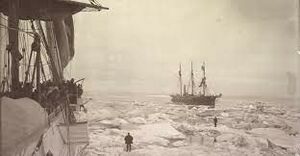
The return to New Archduchy was considerably less enthusiastic as the brave adventurers had lost so many of their own, and the government became incredibly hesitant to grant further funding for these expeditions. However, the Newarc Transpolar Investigatory Commission was formed by the Foreign Office in conjunction with the Republican Navy to investigate the sinking of the Forthright, and found that rushed preparations, poorly-trained and under-equipped crew, and a lack of experienced Arctic sailors had led to the demise of the Forthright. From these findings, the government began to work on codifying the requirements for future expeditions should one be made, and recommended that much more time and effort be invested into future expeditions in order to minimize unnecessary loss of life. Hetherington, in his memoirs, stated that the loss of the Forthright was indeed entirely preventable, and that only a mad frenzy to foster another successful expedition so soon after the 1891 expedition led to the deaths of almost thirty men.
Expedition of 1899
After the loss of the Forthright in 1892, John Howland had been determined to make another expedition north and set up a long-term survey and research camp dedicated to scientific research, provided that further Arctic expeditions were still feasible. Howland entreated the Newarc Transpolar Investigatory Commission twice to no avail, once in 1894 and once in 1896, for a new expedition to be made. Finally, the decision was made to permit the sailing of a single ship and crew to minimize the fallout should it be lost much like the ill-fated Forthright. Howland during this time had kept up his academic research and preparations, leading a pair of mountaineering expeditions to the mountains of Kuronia in 1895 and 1896. From this, he had cultivated an experienced team of civilian and military explorers. However, with the turn of the century and a renewed effort to cement Newarc national identity, Michael Ailio, who by then had had his post renamed to Popular Regent, approved a limited expedition of a single ship to the Arctic, with the caveat it was led by Howland and that the team was comprised of experienced volunteers. Concurrent to this, oversight from the Newarc Transpolar Investigatory Commission for the expedition's preparation, which was based off of their 1892 report on the previous expedition's shortcomings and failures, were mandated.
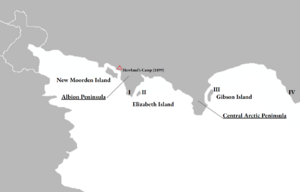
Howland accepted the terms and in the summer of 1897 began a two-year plan to prepare his teams for what they would experience. He recruited his land contingent from not only the mountaineers and alpine experts of Kuronia, but he specifically picked his maritime and naval contingent from a mixture of 1891 and 1892 veteran sailors, augmenting them with whalers from Burgundie as best as he could. Howland felt they brought the rough sea experience that was lacking in 1892 which would make the difference for the longer, more difficult expedition in 1899. The maritime contingent specifically focused on sailing in rough seas, going through drills, procedures, and contingencies that would help them excel in these conditions. In this instance, the joint Newarc-Kuronio-Burgoignesc team would set the conditions for a successful maritime navigation to the Arctic. Douglas Shaw, the descendant of blockade runner Timothy Shaw of Cronan Beaver War fame, had made a name for himself in the Navy in 1894 when he took a small sloop from Adriansville and sailed to the Delepasian capital of Santa Maria in record time; making it the first time a sailor from Crona had sailed directly to Vallos with only a two-masted sloop intended for Cronan travels. Shaw would be complemented by Lucien Boissieu, a whaler from Burgundie who had recently travelled to New Archduchy to begin whaling in the Odoneru Ocean. His experience with the type of long-distance, expeditionary sailing, combined with Shaw's emphasis on preparation and robust training created a solid naval complement for the journey.
Howland tasked both Shaw and Boissieu together to find a ship suitable for the journey. In this instance, they found in the port of Adriansville the Defiance, a three-masted schooner, that was being refit as a whaler. Upon a petition by the Newarc government, it was purchased for NA£19,000 and was to undergo retrofitting for the Arctic exploration in 1899. The land contingent procured sleds, cold-weather clothing, and the required equipment they would need for an extended stay at the Arctic shores. In January 1899, the Defiance left the port of Adriansville. With a complement of fifty six, it had nearly half a complement more than what it had been designed for, and the living conditions were increasingly cramped as a result. However, between Howland, Shaw, and Boissieu, the voyage north was made in record time, and they arrived in the northern shores of the Albion Sea after roughly two and a half months travel, skipping Xepramonta and travelling the Albion Sea without the need for a resupply stop.
The search began for an initial place from where to encamp and begin their surveys, studies, and observations in the Arctic. Secondary to this, Howland had began preparations to petition the Common Council for a longer expedition that would permit a single team to make the trip to the North Pole. Howland at this time had discovered a new island which was previously unmapped and what many had thought to be part of the Arctic mainland. New Moorden Island, the westernmost of the three Arctic Albion Islands, was also the largest, and there was a brief two-day expedition led by Howland inland while Shaw and Boissieu undertook necessary repairs and maintenance on the Defiance. On New Moorden, the highest point proved to be a good vantage point for Howland, upon which he used his telescope and survey equipment to identify suitable future spots for expeditions on the island, as well as a small deep-water inlet which he believed could serve as the basis for a future Newarc colony. Upon Howland's return to the encampment, the expedition departed in late April and arrived at the mainland shore, from where Howland set up a permanent encampment for the next months. The weather by now, being in the summer, was far more permissible, but they knew they would be here for much longer than that. By day, temperatures remained around 10°C, but by night they dropped to just below zero. The warmest day recorded was in the last week of June with a daily high of 19°C. During the day, small expeditions and forays inland were made to try and discover new sights and conduct additional land and coastal surveys. A pair of biologists from the Arses Memorial University also catalogued at least three species of bird, and several small land mammals, such as hares and marmots. The sailors themselves assisted with the aquatic portion of this, working with the scientists to fish and trap sea life on the shore, which also provided them with activities outside of the maintenance and repair of the Defiance and their camp routines. Inland, a pair of infantrymen from the Republican Army sighted the first large land mammal in the Arctic discovered by a Newarc expedition, the Albion Wolf. Credited with the first successful hunt of one, Lieutenant Corporal Hamish Bailey was noted to have shot it with a trapdoor rifle at a distance of approximately 320 yards. Its pelt is still on display in the Sergeants' and Warrant Officers' Mess at New Archduchy's main army base in Adriansville.
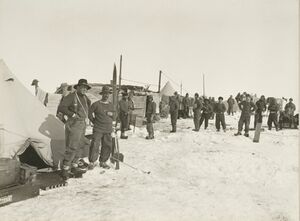
By late September, the weather had began to turn and plans for the journey home began to be finalised. Scientists were told that by New Year's Day, the Defiance would be setting sail to return to New Archduchy. With final expeditions and samples taken, the scientific contingent was ready to go by Christmas Day, on which the entire expedition's complement enjoyed salted fish, brandy, and marmot jerky with dried cranberries. Shaw and Boissieu set the departure date for 29 December based off of the limited weather data they had, and the expedition left Howland's Camp that morning.
The return faced a trio of brutal storms, the first keeping them in New Moorden Channel for several days, and once they had survived that and made it to the tip of the Albion Peninsula another storm forced them to shore where they moored near the site of Howland's first shore trip from 1891, just eight years prior. The final storm caught them in open seas as they travelled south back towards mainland Crona, at one point nearly washing Shaw overboard only to be saved by a member of the ship's science company who managed to grab and keep a hold of him.
They arrived back in February 1900, the expedition a resounding success. The scientific data was gleaned, the survey and navigational charts were produced, and the expedition incurred the prestige of being the longest Arctic expedition with zero casualties to date which heralded in a new era of government confidence in further journeys northward. Howland was lauded with scientific and exploratory awards, and his naval subordinates, Shaw and Boissieu each received service medals, with Boissieu's being an honorary one due to his civilian status. The Newarc Transpolar Investigatory Commission report commended the expedition as one of the finest moments of national achievement for New Archduchy, and recommended that Howland be allowed to conduct additional, more lengthy expeditions in the future. Howland, who now felt he had to momentum and popular backing, petitioned the Common Council in April 1900 for another North Pole expedition, which was duly approved, giving him a discretionary budget of NA£250,000 to finance and fund the effort.
Howland's Expedition
Easthampton and Leo
In late April of 1900, Howland met with Douglas Shaw and Lucien Boissieu to discuss the particulars of outfitting a ship for the next expedition. The list was broad and encompassed aspects such as the flexibility to handle the high seas, the rigidity to handle the pack ice, a vast amount of storage for both a commissary and plenty of expeditionary equipment, and accommodations for the crew and pack animals. In the summer of 1900, Shaw and Boissieu set out on a search for a pair of ships that would meet these new specifications. They were unsuccessful, specifically in their attempts to find a ship in the equatorial waters that was, at the same time, flexible and rigid. They reported back in the early autumn and requested to be dispatched further afield. They were given a small stipend and given another six months to find a ship that met all of the specifications. After a series of meetings across the Odoneru it became clear such a ship did not exist and would have to be built. Boissieu convinced Shaw to go to Burgundie and meet with the draughtsmen at Chantiers d'Aristide who specialized in high-endurance whaling and clipper ships. They arrived in early December and laid out their specifications. The draughtsmen worked for three weeks on the design. At one point Shaw became fed up with the waiting and the speed at which Boissieu was burning through their stipend that he began preparations to return.
The plans were for a wooden-hulled Barquentine, made of oak, cross-braced at every joint and fitting, with keel members of four pieces of solid oak, one above the other, adding up to a thickness of 85 in (2,200 mm), while her sides were between 30 in (760 mm) and 18 in (460 mm) thick, with twice as many frames as normal and the frames being of double thickness. The ship was to be built of planks of oak and Wintergenesc fir up to 30 in (760 mm) thick, sheathed in greenheart, an exceptionally strong and heavy wood. The bow, which was designed to meet the ice head-on, had been given special attention. Each timber had been made from a single oak tree chosen for its shape so that its natural shape followed the curve of the ship's design. When put together, these pieces had a thickness of 52 in (1,300 mm). A 350 hp (260 kW) coal-fired steam engine, making the ship capable of speeds up to 10.2 kn (18.9 km/h; 11.7 mph) was also to be installed. It was to be the strongest wooden ship ever built. Shaw and Boissieu were elated but Chantiers d'Aristide wanted NA£50,000 per ship which was too much. They purchased the plans for NA£500 and returned home dejected, but glad that they had made some progress.
Upon their return, in late January, they showed the plans to Howland who became set on having the ships built. He authorized Shaw to return on his own with NA£50,000 and an order to come home with either two ships or NA£50,000. Shaw was halfway back to Burgundie when he discovered Boissieu stowed away on board. After a few days of chastisement, he ultimately resolved himself to Boissieu's presence. Shaw evaded Boissieu at port by bringing him to a bar and made his way to Chantiers d'Aristide to negotiate terms. After a day and a half he was able to get the price for both ships down to NA£70,000 but no further. Boissieu had finally tracked down Shaw and, upon discovering the shortage, challenged the owner of Chantiers d'Aristide to a game of dice. The terms: both ships for NA£50,000 if he won, one ship for NA£70,000 if he lost. Shaw was enraged with Boissieu's interference. The dice was casted among the draughtsmen, and Boissieu won. The owner began to scream and yell, declaring that Boissieu was a cheat. Boissieu calmly asked for the owner's set of dice, cast the dice among the clutter of the workshop and once again won. The owner called for the gendarmes to arrest Boissieu for cheating at dice. Upon arrival, Boissieu produced a pair of weighted dice that he claimed had come from the owner, and the draughtsman swore them to be the owner's dice. The matter was brought to the magistrate and the deal was ordered to be upheld.
Work began on the twin sister ships, Easthampton and Leo, the former being a reference to the many men who came from the Eastern Newarc town, and the latter referencing the Lion, one of New Archduchy's most prominent national symbols, inherited from Urcea.
Howland-Rickett Expedition
Expedition of 1911
Expedition of 1914
Towley Expedition
Austin-Taylor Expedition
Expedition of 1918
Deaths and shipwrecks
Casualties
- Nathan Gibson, 26; Expedition of 1891. Exposure. Buried on Gibson Island.
- Lochlan Robinson, 22; Expedition of 1892. Crushed to death by a falling mast. Buried at Sea.
- Cayden Hall, 29; Expedition of 1892. Crushed to death by a falling mast. Buried at Sea.
Shipwrecks
- Forthright, Schooner; Expedition of 1892. Lost with all 27 lives in the Albion Sea.
Cultural impact
Modern Newarc Arctic expeditions